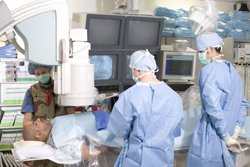
Lung Cancer
What Is lung cancer?

Lung cancer is an uncontrolled growth of abnormal cells in the lungs, leading to the destruction of healthy lung tissue. These cancerous cells grow into tumors that prevent the lungs from working. There are many types of lung cancer: small cell, large cell, squamous cell and adenocarcinoma. Untreated, the cancer may spread to other areas, causing death.
Lung cancer is the leading cause of cancer deaths in both men and women. Less than half of those diagnosed live more than one year.
How can I reduce my risk of lung cancer?
Stop smoking! If you stop now:
- Within 72 hours your bronchial tubes will begin to relax, the lungs’ functional abilities will begin to increase and breathing will become easier.
- Within 1-9 months the cilia in your lungs will have re-grown and will be able to help keep lungs clean and clear again.
- After 10 years, as your lungs heal, your risk for lung cancer will be almost the same as that of a non-smoker.
Avoid secondhand smoke. If you have a loved one who smokes, ask him or her not to smoke near you or in your home.
Avoid radon gas, arsenic, asbestos, radiation and other cancer-causing chemicals.
Lung cancer is the leading cause of cancer deaths
in both men and women.
What causes lung cancer?
There are many causes of lung cancer, but the number one cause is smoking. Chemicals in tobacco smoke damage lung tissue over time and can lead to the growth of cancer. Smoking causes close to 90% of lung cancer cases.
There are many other chemicals we breathe in that can cause cancer as well. Some of these include arsenic, asbestos, radioactive dust particles and radon gas. A family history of cancer as well and the presence of multiple risk factors can also increase your risk of developing lung cancer.
What are the symptoms of lung cancer?
Lung cancer is difficult to detect early because the first symptom may simply be a cough that does not go away. In some cases you may not exhibit symptoms at all. It may take years to develop the symptoms of lung cancer.
As a result, many cases are not detected until the later stages. As the disease progresses you may exhibit:
- Severe shortness of breath
- Persistent coughing or wheezing
- Coughing up blood
- Chest pain
- Fever
- Lung infections
- Weight loss
Once symptoms appear, the disease progresses much faster and becomes more severe. At this point, the disease also becomes harder to treat. As a result, early diagnosis and treatment are key to improving the chance of survival. Talk to your doctor immediately if you believe you may be at risk.
Secondhand Smoke causes approximately 3,000 lung cancer deaths among U.S. non-smokers each year.
Source: United States Surgeon General
Treatment
Once diagnosed, doctors run many tests to find the size, location, type and spread of the cancer. Tests may include but are not limited to: pulmonary function tests; x-rays; sputum examinations; bronchoscopy (through a tube down the nose or mouth); needle aspiration to get a sample of lung tissue; CT or CAT or PET or MRI scans; or bone marrow and lymph node biopsy. Based on test results which show the “stage” of cancer, the doctor may recommend one or more of the following treatments:
Surgery
A major operation is performed to remove the cancerous tissue. Surgery is generally performed when the tumor is small and has not spread outside of the lungs. Pain or weakness in the chest and arm as well as shortness of breath are common side effects. Patients may take weeks or months to recover.
Radiation Therapy
Doctors use high-energy waves to kill cancer cells. Radiation therapy may be used in combination with surgery or by itself. Some common side effects include a sore throat, diffi culty swallowing, fatigue, loss of appetite and skin changes at the site of treatment.
Chemotherapy
A wide range of drugs, both natural and synthetic, may be used to kill cancerous cells throughout the body. Side effects vary based upon specific drugs and dosage, but may include nausea and vomiting, hair loss, mouth sores and fatigue. Chemotherapy is normally given every three to four weeks for a period of at least six months.
Coping with Lung Cancer
In addition to the physical and medical challenges, living with lung cancer may also present emotional, social and spiritual issues. Addressing these concerns properly and maintaining a positive outlook, can improve a lung cancer patient’s quality of life and physical health. Cancer support groups provide an opportunity for cancer patients and survivors to share their experiences with peers.
For more information about lung cancer and programs available in your area, contact your local Breathe California office.